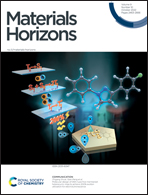A phonic Braille recognition system based on a self-powered sensor with self-healing ability, temperature resistance, and stretchability†
Abstract
Braille recognition is of great significance for the visually impaired and blind people to achieve convenient communication and learning. A self-powered Braille recognition sensing system with long-term survivability and phonic function could provide those people with greatly enhanced access to information and thus improve their living quality. Herein, we develop a skin-like self-powered Braille recognition sensor with self-healing, temperature-resistant and stretchable properties, which is further connected with the designed audio system to realize real-time conversion from mechanical stimulus to electrical signals and then to audio signals. The sensor is fabricated using dynamic interaction-based self-healing materials, which constitute an imine bond-based cross-linked polymer for the triboelectric layer and a hydrogen bond-based organohydrogel for the electrode layer. Moreover, the conductive organohydrogel-based electrode is provided with stretchable, anti-freezing, and non-drying properties. Consequently, minimized impact on the output performance of the sensor is found under mechanical impact, harsh environments and large deformation, enabling a long lifespan, high durability, and good stability. The self-powered sensor can be applied in a Braille recognition system, in which the Braille characters can be further decoded and read out. This work shows a reliable and flexible device with promising prospects in information technology.



 Please wait while we load your content...
Please wait while we load your content...